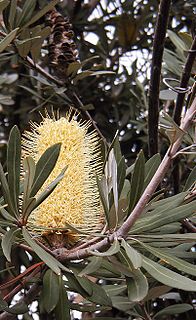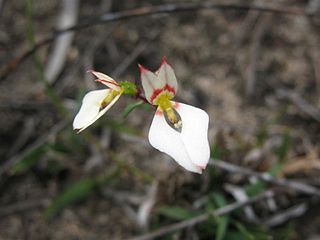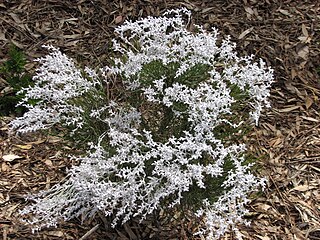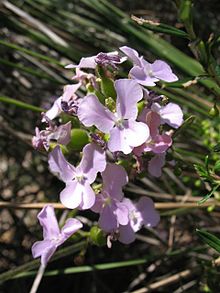
The taxonomy of Banksia integrifolia has a long and complex history, the result of confusion caused by the species' great variability, and similarities with some closely related species. The existence of hybrids between B. integrifolia and related species as well as early attempts to classify the species based on dried specimen material have also contributed to the confusion.
Banksia proteoides, commonly known as king dryandra, is a shrub endemic to Western Australia. It was known as Dryandra proteoides until 2007, when all Dryandra species were transferred to Banksia by Austin Mast and Kevin Thiele.

Grevillea flexuosa, commonly known as zigzag grevillea or tangled grevillea, is an endangered shrub endemic to Western Australia.

Levenhookia, also known as the styleworts, is a genus of ten recognized species in the family Stylidiaceae and is endemic to Australia. The genus is restricted to Western Australia almost exclusively with a few exceptions: L. pusilla's range extends into South Australia, L. dubia's range extends through South Australia into Victoria and New South Wales, L. sonderi is native only to Victoria, and L. chippendalei is also found in the Northern Territory.
Conospermum acerosum, commonly known as needle-leaved smokebush, is a shrub endemic to Western Australia

Conospermum stoechadis, commonly known as common smokebush, is a shrub endemic to Western Australia.
Atriplex paludosa subsp. baudinii is subspecies of Atriplex paludosa that is endemic to Western Australia.
Banksia fraseri var. fraseri is a variety of Banksia fraseri. As an autonym, it is defined as encompassing the type material of the species. It was known as Dryandra fraseri var. fraseri until 2007, when Austin Mast and Kevin Thiele sunk all Dryandra into Banksia. As with other members of Banksia ser. Dryandra, it is endemic to the South West Botanical Province of Western Australia.
Banksia subpinnatifida var. subpinnatifida is a variety of Banksia subpinnatifida. As an autonym, it is defined as encompassing the type material of the species. It was known as Dryandra subpinnatifida var. subpinnatifida until 2007, when Austin Mast and Kevin Thiele sunk all Dryandra into Banksia. As with other members of Banksia ser. Dryandra, it is endemic to the South West Botanical Province of Western Australia.
Banksia densa var. densa is a variety of Banksia densa. It was known as Dryandra conferta var. conferta until 2007, when Austin Mast and Kevin Thiele sunk all Dryandra into Banksia. Since the name Banksia conferta had already been used, Mast and Thiele had to choose a new specific epithet for D. conferta and hence for this variety of it. As with other members of Banksia ser. Dryandra, it is endemic to the South West Botanical Province of Western Australia. As an autonym, it is defined as encompassing the type material of the species.
Banksia dallanneyi var. dallanneyi is a variety of Banksia dallanneyi subsp. dallanneyi. It was known as Dryandra lindleyana var. lindleyana until 2007, when Austin Mast and Kevin Thiele sunk all Dryandra into Banksia. Since the name Banksia lindleyana had already been used, Mast and Thiele had to choose a new specific epithet for D. lindleyana and hence for this variety of it. As with other members of Banksia ser. Dryandra, it is endemic to the South West Botanical Province of Western Australia. As an autonym, it is defined as encompassing the type material of the species.
Banksia leptophylla var. leptophylla is a variety of Banksia leptophylla. It is native to the Southwest Botanical Province of Western Australia. As an autonym, it is defined as containing the type specimen of the species.
Banksia nutans var. nutans is a variety of the plant Banksia nutans. It is native to the Southwest Botanical Province of Western Australia. As an autonym, its name is defined as containing the type specimen of the species.

Banksia sphaerocarpa var. sphaerocarpa is a variety of Banksia sphaerocarpa. It is native to the Southwest Botanical Province of Western Australia. As an autonym, it is defined as containing the type specimen of the species.

Stylidium rupestre is a dicotyledonous plant that belongs to the genus Stylidium, a species sometimes named as the rock triggerplant. It is found in Southwest Australia. The species was first described by Otto Wilhelm Sonder.

Stylidium spathulatum is a dicotyledonous plant that belongs to the genus Stylidium. The species is informally named the creamy triggerplant for the colour of its flowers.
Plantago debilis is a species of herb native to Australia. Common names include shade plantain and weak plantain.

Adenanthos macropodianus, commonly known as gland flower, or Kangaroo Island gland flower, is a species of shrub in the family Proteaceae. It is endemic to Kangaroo Island in South Australia. First published as a variety of A. sericeus in 1870, it was promoted to species rank in 1978.

Adenanthos sect. Adenanthos is a taxonomic section of the flowering plant genus Adenanthos (Proteaceae). It comprises 29 species. The centre of diversity is southwest Western Australia, with two species extending into South Australia and western Victoria.










